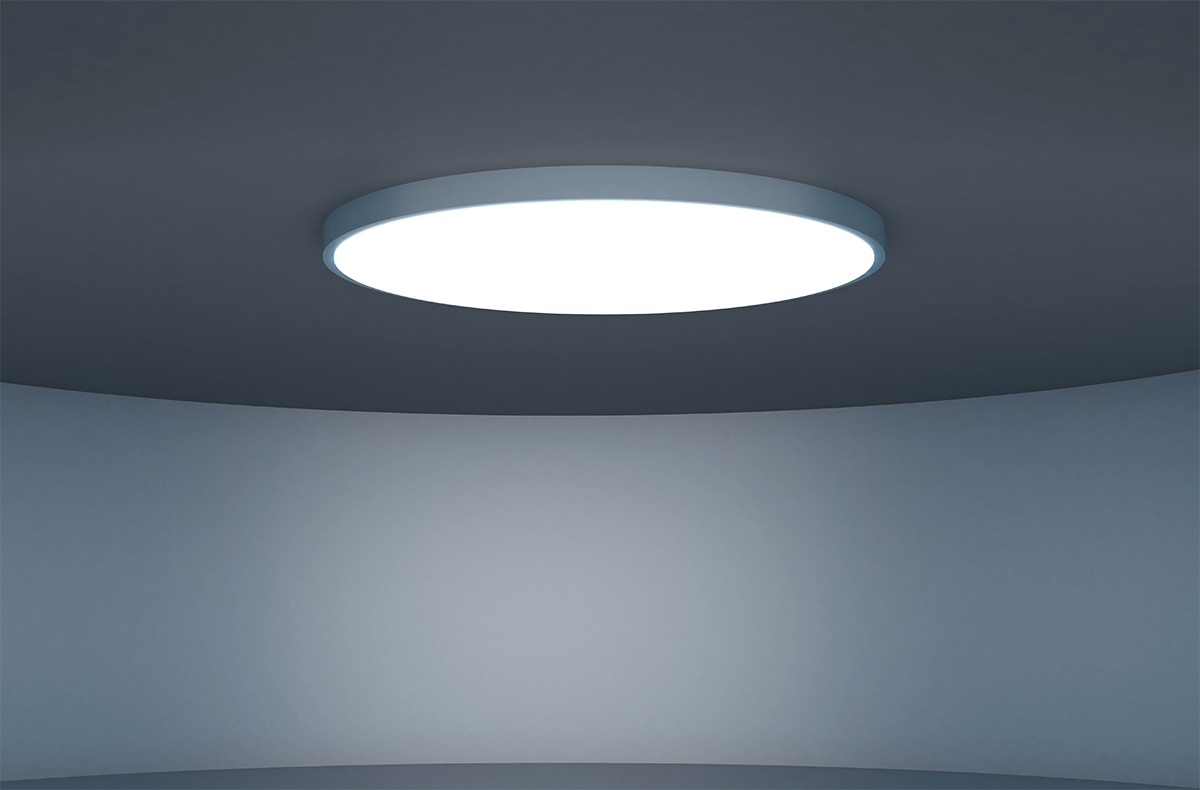What is a smart ceiling light
A smart ceiling light is a wirelessly networked luminaire that can be operated from a mobile app run on an IP-enabled device. It connects to your iOS or Android smartphone or tablet via a wireless communication interface, allowing lighting to be controlled, programmed, personalized and automated conveniently from anywhere. Ceiling lights are those things that most of us tend to overlook or take for granted—but they contribute immensely to the visual environment.
As an integral element of most lighting schemes, ceiling-mounted fixtures are used to provide an ambient or task layer of light in living rooms, foyers, bedrooms, kitchens, dining rooms, kitchens, garages, utility rooms, closets, offices, hallways and stairways. Their ubiquitous presence deems their inescapable influence on our quality of life. How the light fixtures perform has everything to do with the look, feel and visibility of an environment. Composed by uniting all building blocks in an intelligent, connected system, a smart ceiling light delivers the ability for us to manage and optimize the environment in a creative, comfortable, and enjoyable way.
Stay abreast of the evolving lighting concept
Smart ceiling lights are created to support the evolving lighting concept, which is now pursuing to control, with extraordinary user experience, every aspect of lighting for positive effects on human health and visual functions. Building network connectivity into the luminaire to enable human interaction and device interoperation is an integral condition for smart lighting implementation. Just as important is the ability of a smart light to respond to the changing contexts and human needs.
A lighting system that can’t be dynamically customized to user needs is inherently devoid of adaptability and flexibility. In residential and hospitality applications, the dynamics of lighting transcend the adjustability and controllability for a high level of automation and energy effectiveness. Spectral tunability has become a critical demand as the amount of energy emitted as various wavelengths has implications beyond simple vision and color perception. Human centric lighting (HCL) which adapts to follow the patterns of normal daylight is at the core of this trend. It takes into account the visual, emotional and biological effects of light to provide visual satisfaction while also stimulating non-visual effects on human psychology and physiology.
LED technology unlocks far-reaching smart lighting potentials
Technology advances are converging today to create sophisticated lighting solutions that support conversation between diverse devices. Within the interdependent smart lighting ecosystems, LED technology plays a pivotal role in unlocking the power of advanced controls and networking technologies.
LEDs are semiconductor packages that produce light through recombination of electrons and holes in the active layer (quantum well) which is interposed between the n-type semiconductor layer and the p-type semiconductor layer. The injection electroluminescence occurs almost instantaneously when the p-n junction is biased in the forward direction. The magnitude of injection electroluminescence responds to real-time changes in the current flowing through the LED. By nature, the intensity of the LEDs can simply be varied by changing the DC magnitude of the current provided to the LED. LED dimming can also be achieved by controlling the duty cycle of the current pulse.
The ability to instantaneously respond to control input, provide variable light output over a full, precisely controllable range and withstand constant on/off switching without premature failure allows LEDs to dynamically and accurately execute control logic which is a key part of a software program. By taking advantage of the superior dimmability, the LED technology platform also offers the new capability of actively controlling the spectral power distribution (SPD) of a multi-die LED package or a multi-channel LED module to produce predictable colors within the color-mixing gamut. The implementation of this feature opens up a whole new world of possibilities to enhance the pleasantness of interior spaces and drive the trend towards HCL.
System design
Smart ceiling lights come in a variety of different designs and styles. Nevertheless, they are all integrated LED systems that rely on the collaborative work of all constitutive components to perform at their best. The light-producing component usually takes the form of LED modules which are assemblies of SMD LED populated onto metal-core PCBs. Typically, smart ceiling lights use conventional semiconductor packages that are operated by external LED drivers.
Color mixing systems incorporate multiple circuits/strings of LEDs. Each LED string is individually driven and controlled. Dim-to-warm and tunable white systems require a minimum of two independent LED primaries. Full-color tuning lights often add additional colors, such as amber and white, to RGB systems to expand the gamut and produce high quality white light.
What differentiates a smart ceiling light from its counterpart is the electronic system. As opposed to a dumb product that uses only a driver circuit to provide basic current regulation, the electronic system of a smart product is a complete set of system composed of circuits for drive current regulation, signal processing, conditional programming, and wireless network communication. Additionally there may be occupancy sensing and daylight harvesting circuits. Intelligence is embedded into the lighting system. Sophisticated systems are frequently combined with intelligence provided by software in the cloud for more powerful processing and data mining.
LED driver
Smart lighting systems rely on the LED driver to execute the control commands, which adds another layer of importance to the driver circuit design. The current-dependent LEDs need to be properly driven to ensure optimal performance over the rated life. The LED driver is designed to provide constant current to the load, regardless of fluctuation in the supply voltage or LED forward voltage. In AC/DC power conversion, large ripples must be suppressed to avoid light flicker.
In most smart lighting applications, it’s the dimming performance of the LED driver that determines the viability of a control strategy. Simple dimming is usually accomplished through constant current reduction (CCR) which is commonly known as analog dimming. Dimming with CCR involves adjusting the drive current flowing continuously to the LEDs, which is simple and less expensive to implement. This method, however, suffers from color shift and limited dimming ranges.
Tunable white lighting and full-color tuning systems generally require accurate dimming control of their component LEDs. Accurate control on each channel is usually provided using the pulse-width modulation (PWM) method. PWM or digital dimming involves adjusting the duty cycle of the current pulses going through the LEDs. The duty cycle may vary from 0% to 100% to support full-range, digitally controllable dimming.
Light controller
At the heart of a smart ceiling light is a controller that interfaces the light engine to control devices, network servers and the environment. The light controller is the device that originates all the instructions for operating the LED driver which in turn provides on/off switching and dimming control of the connected LEDs. It communicates with an IP-enabled device or cloud server to transmit and receive data which includes commands and information necessary for programming, monitoring and control of the LED ceiling light. The controller also receives inputs from connected sensors and other smart nodes, converts analog signals into digital signals, and acts on triggers to initiate a control command.
A light controller is implemented as an assembly that typically includes a microprocessor core, computer memory, transceiver IC, and input/output (I/O) ports. The microprocessor runs software programs stored in computer memory to decode control signals, program instructions and operate triggers. The transceiver allows data to be sent and received wirelessly between the controller and network gateway.
Communication protocol
Remote connectivity is one of the key capabilities for smart ceiling lights as it allows the lights to connect to the Internet via the gateway and, in some applications, needs to enable the communication between the smart nodes within a wireless network. A communication protocol must be defined to facilitate the connection, communication and data transfer between network devices and gateways.
Wireless communication protocols that are used often in smart ceiling lights include Wi-Fi, ZigBee, Bluetooth and Z-Wave. Wi-Fi supports longer range transmissions and higher speed of communications. However, the popularity of this technology resides in its existing ubiquity and convenience of use. ZigBee, Z-Wave and Bluetooth are key solutions that drive the adoption of digital lighting. The ZigBee standard brings more interoperability to lighting control and has excellent network scalability. As with ZigBee, Z-Wave is designed for low-power and highly reliable mesh networking applications, but this topology suffers from limited broadcasting range and network scalability. ZigBee and Z-Wave devices require the use of a hub or bridge that connects with a Wi-Fi router and talks to smart ceiling lights.
Bluetooth is a protocol that is directly supported by smartphones or tablets, which is also a feature shared by Wi-Fi. With Bluetooth Low Energy (BLE) control, however, the wireless communication range is often too short to give you sufficient freedom of movement. The protocol supports communication with a very small number of lights.
App control
Today, mobile applications designed to run on smartphones or tablets are fully meshed into the concept of smart lighting. A mobile app intuitively guides speedy set-up and provides multifaceted ways to play with the smart light virtually from anywhere on the planet. Turn individual lights or groups of lights on or off, or dim them either on command or by a preset program. Adjust the color temperature and light intensity to benefit circadian photoentrainment. Transform a space with vibrant, colorful scenes with dynamically changing colored light. Set up wake, sleep, away, and vacation mode automations. Synchronize lights to the beat of music, movies and games for immersive effects. Connect the lights to Amazon Alexa, Apple HomeKit or Google Assistant and allow them to respond to your voice commands. Integration with a task automation platform such as IFTTT gives you creative control over the products.



















Loading...